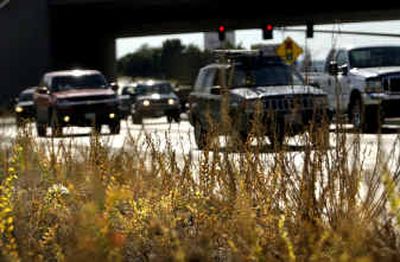Budget cuts, rainy spring sow banner crops of weeds

Sunshine + rain + seeds = weeds.
That formula is playing out all over Spokane County this summer. Weeds in some medians and along roadways resemble small trees, but budget constraints are making it impossible to keep up with the spraying and mowing it takes to tame them, government employees say.
Now, July’s here and the weeds are drying out. That means herbicides will lose their efficacy and the weeds will go to seed.
What does that do to the formula above? Multiplication, baby.
“I think we need to be doing more to protect our natural resources,” said David Mundt, coordinator of the Spokane County Noxious Weed Board. “Unfortunately, it’s getting the budget cut, and that’s not good.”
Weeds aren’t just ugly. They can choke out other plants, alter the natural ecology of an area and decrease property values.
Some Spokane-area spots are plagued more than others. Along Sprague Avenue, just east of Fancher Road in Spokane Valley, noxious weeds cover a hillside. Across from the Sundance Plaza Shopping Center in northwest Spokane, thick weeds surround young trees the city of Spokane planted about six years ago as part of a beautification project.
Government employees said their hands are tied.
“It’s a frustration for us,” said Scott Egger, Spokane’s Street Department director. “We wish we had the funding and the resources to not only do noxious and minimal weed removal, we would like a full-fledged landscaping effort to make the city beautiful.”
But Egger’s road maintenance department, which includes the people who remove weeds, fill potholes, sweep streets and do other tasks, has 69 employees – down nine positions compared with last summer. The city is struggling to write its 2005 budget and recently enlisted the help of citizens to provide input on what services should be cut to save money.
Spokane Valley contracts for weed control with Spokane County. It has directed the county to do the same level of weed abatement typically done in years past, said Neil Kersten, the city’s Public Works Director. He said the city has received few complaints about weeds this year.
The weed problem has an ironic twist in Spokane, where the comprehensive land-use plan requires attractive landscaping be put in with new road projects. The Indian Trail streetscape was beautified through that law, but the city doesn’t set aside specific funds to maintain those areas once they’re created. Whereas weeds might not have existed there before, the new landscaping and its sprinkler system provide a breeding ground for them, and citizens tend to notice when the once-appealing areas begin to deteriorate, Egger said.
“It’s kind of an unfunded mandate,” he said.
Spokane is taking steps to alleviate the problem by enlisting volunteers. Urban planner Dave Steele heads up the Adopt-a-Boulevard program, in which citizens maintain areas themselves. Spots along Northwest Boulevard, at Southeast Boulevard and 29th Avenue and areas under Interstate 90 have been cleaned through this effort.
“We’re trying to put that right foot forward,” Steele said.
Mundt said weeds are particularly prolific this summer because of higher-than-usual rainfall in May and early June.
As cars drive through town, seeds attach to them and are spread. Weeds also sprout in gravel piles, so seeds can spread during road construction projects, Mundt said.
The Noxious Weed Board notifies both private individuals and government bodies when it finds problems, but it can be difficult to ask homeowners to remove weeds when the cities and the county aren’t setting a good example, he said.
“That’s where it gets frustrating for us,” Mundt said. “We’re working with property owners, yet across the way there’s city- or county-owned property that’s not controlled.”